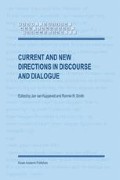Abstract
The ability to request clarification of utterances is a vital part of the communicative process. In this paper we discuss the range of possible forms for clarification requests, together with the range of readings they can convey. We present the results of corpus analysis which show a correlation between certain forms and possible readings, together with some indication of maximum likely distance between request and the utterance being clarified. We then explain the implications of these results for a possible HPSG analysis of clarification requests and for an ongoing implementation of a clarification-capable dialogue system.
Access this chapter
Tax calculation will be finalised at checkout
Purchases are for personal use only
Preview
Unable to display preview. Download preview PDF.
References
Allen, J. and Core, M. (1997). Draft of DAMSL: Dialog act markup in several layers.
Bohlin (LjunglΘf), P., Cooper, R., Engdahl, E., and Larsson, S. (1999). Information states and dialogue move engines. In Alexandersson, J., editor, IJCAI-99 Workshop on Knowledge and Reasoning in Practical Dialogue Systems.
Burnard, L. (2000). Reference Guide for the British National Corpus (World Edition). Oxford University Computing Services.
Carletta, J. (1996). Assessing agreement on classification tasks: the kappa statistic. Computational Linguistics, 22(2):249–255.
Clark, H. H. (1996). Using Language. Cambridge University Press.
Fletcher, C. (1994). Levels of representation in memory for discourse. In Gernsbacher, M., editor, Handbook of Psycholinguistics. Academic Press.
Ginzburg, J. (1996). Interrogatives: Questions, facts and dialogue. In Lappin, S., editor, The Handbook of Contemporary Semantic Theory, pages 385–422. Blackwell.
Ginzburg, J. and Cooper, R. (2001). Resolving ellipsis in clarification. InACL/EACL01 Conference Proceedings. Association for Computational Linguistics.
Ginzburg, J. and Cooper, R. (forthcoming). Clarification, ellipsis and utterance representation.
Ginzburg, J., Gregory, H., and Lappin, S. (2001a). SHARDS: Fragment resolution in dialogue. In Bunt, H., van der Sluis, I., and Thijsse, E., editors, Proceedings of the Fourth International Workshop on Computational Semantics (IWCS-4), pages 156–172. ITK, Tilburg University, Tilburg.
Ginzburg, J. and Sag, I. (2000). Interrogative Investigations: the Form, Meaning and Use of English Interrogatives. Number 123 in CSLI Lecture Notes. CSLI Publications.
Ginzburg, J., Sag, I. A., and Purver, M. (2001b). Integrating conversational move types in the grammar of conversation. In Kuhnlein, P., Rieser, H., and Zeevat, H., editors, Proceedings of the Fifth Workshop on Formal Semantics and Pragmatics of Dialogue (BI-DIALOG 2001), pages 45–56.
Larsson, S., Ljunglef, P., Cooper, R., Engdahl, E., and Ericsson, S. (2000). GoDiS — an accommodating dialogue system. In Proceedings of ANLP/NAACL-2000 Workshop on Conversational Systems.
Purver, M. (2001). SCoRE: A tool for searching the BNC. Technical Report TR-01-07, Department of Computer Science, King’s College London.
Ross, J. R. (1969). Guess who? In Binnick, R. I., Davison, A., Green, G., and Morgan, J., editors, Papers from the Fifth Regional Meeting of the Chicago Linguistic Society, pages 252–286. CLS, University of Chicago.
Sachs, J. D. (1967). Recognition memory for syntactic and semantic aspects of connected discourse. Perception and Psychophysics, 2:437–442.
Traum, D. (1994). A Computational Theory of Grounding in Natural Language Conversation. PhD thesis, University of Rochester.
van Dijk, T. A. and Kintsch, W. (1983). Strategies of Discourse Comprehension. Academic Press.
Author information
Authors and Affiliations
Editor information
Editors and Affiliations
Rights and permissions
Copyright information
© 2003 Springer Science+Business Media Dordrecht
About this chapter
Cite this chapter
Purver, M., Ginzburg, J., Healey, P. (2003). On the Means for Clarification in Dialogue. In: van Kuppevelt, J., Smith, R.W. (eds) Current and New Directions in Discourse and Dialogue. Text, Speech and Language Technology, vol 22. Springer, Dordrecht. https://doi.org/10.1007/978-94-010-0019-2_11
Download citation
DOI: https://doi.org/10.1007/978-94-010-0019-2_11
Publisher Name: Springer, Dordrecht
Print ISBN: 978-1-4020-1615-8
Online ISBN: 978-94-010-0019-2
eBook Packages: Springer Book Archive

